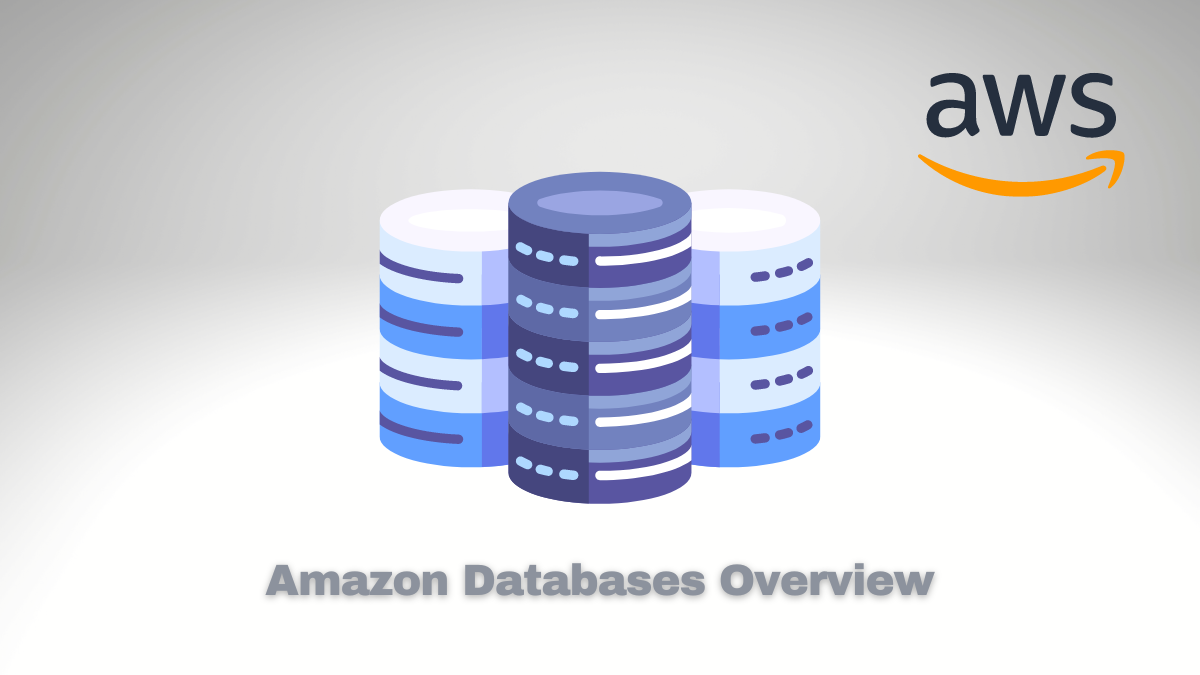A Detailed Guide to AWS Databases

Amazon Web Services (AWS) provides a wide range of database services designed to meet the needs of different types of applications. In this article, we will provide a detailed guide to each of the databases available on AWS, including their strengths and weaknesses and in which scenarios they are most suitable.
Benefits of using AWS databases:
1. Scalability
AWS databases are designed to be highly scalable, allowing applications to handle large amounts of data and traffic without experiencing performance issues.
2. Availability
AWS databases are designed to be highly available, ensuring that applications can always access data. This is achieved through features such as automatic failover and multi-AZ deployments.
3. Security
AWS databases are designed to be highly secure, with features such as encryption at rest and in transit, network isolation, and fine-grained access control.
4. Cost-effectiveness
AWS databases are designed to be cost-effective, with features such as pay-as-you-go pricing, automatic scaling, and reserved instances.
5. Flexibility
AWS databases are designed to be flexible, supporting a wide range of database engines and data models. This allows applications to choose the database that best fits their needs.
6. Managed service
AWS databases are fully managed, meaning that AWS takes care of the database’s maintenance, patching, and backups. This allows developers to focus on building their applications rather than managing their databases.
How to Learn More
Download our free AWS Learning Kit today and start your journey to a successful career in cloud computing!
AWS is the leading cloud computing platform and will only become more critical in the future. With AWS, you can build, deploy, and scale applications quickly and easily, and you can access a wide range of services that can help you save money and improve your business.

AWS Learning Kit – VPC Mind Map
Our AWS Learning Kit will teach you everything you need to know to start with AWS. You’ll learn about the different AWS services, how to use them, and how to build and deploy applications on AWS. You’ll also learn about the AWS certification exams to get certified and make yourself more marketable to employers.
Don’t wait any longer. Download our free AWS Learning Kit today!
Here are just a few of the benefits of learning AWS:
- Increased job security: Cloud computing is a rapidly growing field with a high demand for skilled AWS professionals. By learning AWS, you can increase your chances of finding a job in this growing field.
- Higher salaries: AWS professionals typically earn higher salaries than their non-AWS counterparts. In fact, according to a recent study by Dice, AWS-certified professionals earn an average of $15,000 more annually than non-certified professionals.
- More opportunities: Learning AWS can open up new opportunities for you in your career. For example, you may be able to move into a more senior role, or you may be able to start your own business.
So what are you waiting for? Download our free AWS Learning Kit today and start your journey to a successful career in cloud computing!
Amazon Relational Database Service (RDS)
Amazon RDS is a managed database service that supports relational engines such as MySQL, PostgreSQL, Oracle, and Microsoft SQL Server. It is suitable for applications that require a traditional relational database management system. RDS is a good choice for applications that require ACID compliance, transactional consistency, and support for complex queries. RDS provides automatic backups, software patching, and automatic host replacement, making it easy to manage and scale.
Examples of use cases:
– Content management systems that require a relational database
– E-commerce platforms that require a relational database
– Customer relationship management systems that require a relational database
Strengths:
– ACID compliance
– Transactional consistency
– Support for complex queries
Weaknesses:
– Limited scalability
– Limited to a maximum of 5 read replicas
Amazon DynamoDB
DynamoDB is a type of database service called NoSQL that Amazon manages. It provides fast and reliable performance and is excellent for applications that need quick data access and can grow in size. DynamoDB is a good option for applications that need to handle a lot of data being written constantly, need quick response times, and can automatically adapt to handle changes in demand. The service has automatic backups and software updates and will automatically replace failed components. This makes it easy to manage and grow.
Examples of use cases :
– Gaming applications that require low latency and high scalability
– Ad tech applications that require low latency and high scalability
– IoT applications that require low latency and high scalability
Strengths:
– Low latency data access
– High scalability
– Automatic scaling
Weaknesses:
– Limited query flexibility
– Higher cost compared to other NoSQL databases
Amazon Aurora
Amazon Aurora is a MySQL and PostgreSQL-compatible relational database engine designed for high performance and availability. It is suitable for applications that require high throughput and low latency. Aurora is a good choice for applications that require high availability, automatic failover, and fast replication. Aurora provides automatic backups, software patching, and automatic host replacement, making it easy to manage and scale.
Examples of use cases:
– Gaming applications that require high performance and availability
– Financial applications that require high performance and availability
– E-commerce platforms that require high performance and availability
Strengths:
– High performance and availability
– MySQL and PostgreSQL compatibility
– Automatic failover
Weaknesses:
– Higher cost compared to other databases
– Limited to a maximum of 15 read replicas
Amazon DocumentDB
Amazon DocumentDB is a fully managed NoSQL document database service compatible with MongoDB. It is suitable for applications that require a flexible data model and high scalability. DocumentDB is a good choice for applications that require high write throughput, low latency, and automatic scaling. DocumentDB provides automatic backups, software patching, and automatic host replacement, making it easy to manage and scale.
Examples of use cases:
– Content management systems that require a document database
– E-commerce platforms that require a document database
– Customer relationship management systems that require a document database
Strengths:
– MongoDB compatibility
– Flexible data model
– High scalability
Weaknesses:
– Limited query flexibility
– Higher cost compared to other document databases
Amazon Neptune
Neptune is a managed graph database service offered by Amazon. It is designed to store and search highly interconnected data and is especially useful for complex relationship modeling and analysis applications. Neptune is an excellent option if you need scalability, fast queries, and support for graph data models. It offers automatic backups, software updates, and host replacement for easy management and expansion.
Examples of use cases:
– Social networking applications that require a graph database
– Recommendation engines that require a graph database
– Fraud detection systems that require a graph database
Strengths:
– Optimized for storing and querying highly connected data
– Fast query performance
– Support for graph data models
Weaknesses:
– Higher cost compared to other graph databases
– Limited to a maximum of 15 read replicas
Amazon ElastiCache
Amazon ElastiCache is a fully managed in-memory data store and cache service that supports popular open-source in-memory data stores such as Redis and Memcached. It is suitable for applications that require low-latency data access and high throughput. ElastiCache is a good choice for applications that require fast data access, high concurrency, and automatic scaling. ElastiCache provides automatic backups, software patching, and automatic host replacement, making it easy to manage and scale.
Examples of use cases for Amazon ElastiCache:
– Session caching in web applications
– Caching frequently accessed data sets
– Storing real-time analytics and reporting data sets
– Caching application correct management information that requires low latency access.
Strengths:
– Low latency data access and high throughput
– Fast data access, high concurrency, and automatic scaling.
– Automated backups, software patching, and host replacement for easy management and scaling.
Weaknesses:
– Higher cost compared to other caching services
– Limited to a maximum of 15 read replicas.
– No support for Multithreading in Redis.
– Limited scalability due to memory constraints.
Amazon Timestream
Amazon Timestream is a fully managed time series database service optimized for storing and querying time-series data. It is suitable for applications that require high scalability and fast data ingestion and retrieval. Timestream is a good choice for applications that require high write throughput, low latency, and automatic scaling. Timestream provides automatic backups, software patching, and automatic host replacement, making it easy to manage and scale.
Examples of use cases:
– IoT applications that require a time series database
– Industrial telemetry applications that require a time series database
– Log analytics applications that require a time series database
Strengths:
– Optimized for storing and querying time-series data
– High scalability
– Automatic scaling
Weaknesses:
– Limited query flexibility
– Higher cost compared to other time-series databases
Amazon QLDB
Amazon QLDB (Amazon Quantum Ledger Database) is a fully managed ledger database service that provides an immutable, cryptographically verifiable transaction log. It is suitable for applications that require a secure and trusted data store with integrity and flexibility. QLDB is a good choice for applications that require solid transactional consistency, full auditability, and support for structured data models. QLDB provides automatic backups, software patching, and automatic host replacement, making it easy to manage and scale.
Examples of use cases:
– Financial accounting systems that require an immutable ledger database
– Supply chain tracking applications that require a secure data store with integrity
– Regulatory compliance reporting applications that require a reliable audit trail
Strengths:
– Immutable and cryptographically verifiable transaction log
– The system provides reliable transaction consistency, complete traceability, and the ability to work with structured data models.
– Automated backups, software patching, and host replacement for easy management and scaling.
– Low latency data access and high throughput.
Weaknesses:
– Higher cost compared to other ledger databases
– Limited scalability due to storage constraints.
– No support for graph data models.
Amazon Keyspaces
Amazon Keyspaces is a fully managed, highly scalable, and highly available NoSQL database service provided by Amazon Web Services (AWS). It is designed to work with Apache Cassandra, a popular open-source distributed database management system.
Amazon Keyspaces allows you to run Cassandra workloads on AWS without managing the underlying infrastructure. It provides features such as automatic scaling, backup and restore and point-in-time recovery. It is also fully integrated with AWS Identity and Access Management (IAM) and Amazon VPC, allowing you to easily control access to your data and integrate with other AWS services.
Examples of use cases:
Time-series data management: Amazon Keyspaces can manage time-series data, such as sensor data from IoT devices or log data from applications. The service can handle large volumes of data and provide fast access to historical data using its point-in-time recovery feature.
User profile management: Amazon Keyspaces can manage user profiles in a highly scalable and highly available way. The service can store user profile data, such as user preferences, activity history, and social connections, and provide fast access to this data for personalized experiences.
Catalog management: Amazon Keyspaces can manage product catalogs like e-commerce or media catalogs. The service can handle large volumes of product data, provide fast access to this data, and support search and filtering capabilities.
Real-time analytics: Amazon Keyspaces can be used for real-time analytics use cases, such as dashboarding, fraud detection, or recommendation systems. The service can store and retrieve large volumes of data in real-time and support fast query performance using its automatic scaling capabilities.
Gaming leaderboards: Amazon Keyspaces can be used to manage gaming leaderboards in a highly scalable and highly available way. The service can store and retrieve player scores, rankings, and other data and provide fast access to this data for real-time game updates.
Strengths:
– Scalability: Amazon Keyspaces is highly scalable and can handle large volumes of data and high traffic loads without sacrificing performance.
– High Availability: Amazon Keyspaces automatically replicates data across multiple Availability Zones, providing high availability and durability.
– Integration with AWS: Amazon Keyspaces is integrated with other AWS services such as IAM, VPC, and CloudWatch, making it easy to integrate and manage your Cassandra workloads on AWS.
– Compatibility with Cassandra: Amazon Keyspaces is compatible with Apache Cassandra, meaning you can use existing Cassandra drivers, tools, and applications with the service.
Weaknesses:
– Limited Feature Set: Amazon Keyspaces provides robust features for managing Cassandra workloads but may not offer all the features in other NoSQL databases.
– Learning Curve: While Amazon Keyspaces supports CQL and Apache Cassandra APIs, developers unfamiliar with these technologies may face a learning curve when working with the service.
– Vendor Lock-in: As a proprietary service offered by AWS, Amazon Keyspaces may lead to vendor lock-in, making it difficult to migrate to another platform.
– Cost: While Amazon Keyspaces offers a pay-as-you-go pricing model, running a large-scale Cassandra workload on the service may be higher than other NoSQL databases.
Conclusion
AWS offers various databases to suit different needs and use cases. Whether you need a relational database, a NoSQL database, a document database, a wide-column store database, a graph database, a ledger database, or a time series database, AWS has you covered. With its scalability, availability, security, cost-effectiveness, flexibility, and managed service, AWS databases are an excellent choice for any application that requires a reliable and efficient database solution.
When choosing an AWS database, it is essential to consider the specific needs of your application and choose the database that best fits those needs. By doing so, you can ensure that your application can handle large amounts of data and traffic while providing high availability, security, and performance.
Overall, AWS databases are a powerful tool for developers and businesses and can help improve any application’s performance, scalability, and reliability.




Comments